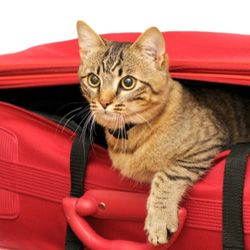 “We love our cats, but we generally don’t love traveling with them. See more cat pictures.©iStockphoto.com/suemack
“We love our cats, but we generally don’t love traveling with them. See more cat pictures.©iStockphoto.com/suemack
As much as we love them, cats generally don’t make the best travel companions. Your dog may happily bound into the back seat of your SUV and slobber in delight while his ears flap in the breeze, but your cat is more likely to dig her claws into the back of your neck and meow in terror the entire ride.
Despite the potential travel tribulations, many cat owners can’t bear the thought of leaving their feline friend in a kennel (a.k.a. "kitty prison") while they go on vacation. If you’re determined to take your cat along wherever you go, you can make the journey easier on both of you by assembling a few very important accessories before you leave.
Here is a list of the 10 must-have travel accessories that you — and your cat companion — should never leave home without. These items will make feeding, caring for and cleaning up after your kitty a whole lot easier.
Contents
- Clean Bill of Health
- Identification
- Comforts of Home
- First-aid Kit
- Toys and Treats
- Makeshift Litter Box
- Water
- Storage and Serving Containers
- Food
- Cat Carrier
10: Clean Bill of Health
Within 10 days of your departure, visit your vet’s office for a check-up to ensure that your pet is healthy enough to travel with you. Your cat needs to be up-to-date on her shots, and you should get written proof of her health with a signed health certificate (also called a Certificate of Veterinary Inspection) and vaccination status (including rabies vaccine status) to take with you.
You may have to show that paperwork, especially if you’re crossing state lines, traveling by air, or leaving the country. If you’re planning to visit a foreign country, check with the embassy or consulate about pet travel regulations. Some airlines also require a separate acclimation certificate to prove that your cat can handle the chilly temperatures in the holding areas, where she may have to wait an hour or two before being put on the flight.
Write up a list to take with you that includes your veterinarian’s phone number, as well as the numbers of a local veterinary hospital in the city where you’re headed and the national animal poison control hotline (888-426-4235). To find a listing of veterinarians and emergency pet hospitals at your destination, contact your state VMS or the American College of Veterinary Emergency and Critical Care.
9: Identification
 “Make sure your kitty has a collar with all of his identification attached before you leave.©iStockphoto.com/PieroPazzi
“Make sure your kitty has a collar with all of his identification attached before you leave.©iStockphoto.com/PieroPazzi
Your vacation will be memorable for all the wrong reasons if your cat runs away while you’re in a strange city. To make your cat much easier to find if he does run away, make sure you’ve got proper identification ahead of time. Buy a secure cat collar with ID tags attached. On those IDs, write your name, address and phone number (including your cell phone number so you can be contacted on the road if someone finds your cat).
Also label your pet carrier with the same information. Add a travel pet tag that includes your contact information at your destination and your cell phone number.
Microchipping is added insurance that your pet will be returned to you if he is found. Cats can slip out of a collar, but microchips are impossible to shake because they’re implanted under the skin. If your cat is found and taken to a vet or shelter, he can be identified through the chip and returned to you. When you get your cat microchipped, make sure the tag includes your most recent contact information, including your cell phone number, so you’ll be easy to reach.
Even though your cat will be with you on the trip, bring along a recent photo of him. If he slips away, a photo is an easier way to identify him than a verbal or written description.
8: Comforts of Home
Traveling to a strange place while confined in a little carrier is enough to stress out even the calmest cat. Help your kitty get acclimated by bringing a few comforts of home with you on the road.
Line her carrier with a favorite blanket that smells like your house, or like you. Also bring along her favorite kitty bed, which will make her feel more secure — especially if she has to be away from you in an unfamiliar setting. Throw a couple of stuffed toys into your suitcase so she has something to snuggle and play with.
7: First-aid Kit
Bring along any medicines your cat will need to stay healthy and calm. That includes all of the pills he normally would take for the amount of days you’ll be away (plus a few extra pills in case you can’t get back home as early as planned), flea and tick medicine if he’s due, and an anti-diarrheal medicine to help avoid unpleasant accidents (ask your vet for a recommendation). Don’t bring along any new medications that your cat hasn’t taken before. You don’t want to risk a reaction while you’re traveling.
Some people like to sedate their cat on long trips, but experts don’t recommend giving cats tranquilizers, because they can raise blood pressure and interfere with body temperature regulation. An animal that’s been sedated can lose its equilibrium, making it hard to stay balanced. If the carrier is being moved or is shaking during a turbulent flight, unsteady balance will increase your cat’s risk of injury.
Your Cat’s First-aid Kit
In case of accidents or emergencies, pack a travel-sized cat first-aid kit that includes all of the following items:
- Gauze
- Nonstick bandages and adhesive for the bandages (never use human Band-Aids on an animal)
- Hydrogen peroxide to induce vomiting if your cat eats something poisonous
- Eye dropper
- Digital thermometer
- Tweezers/scissors
- Cotton balls
- Ear cleaning solution
- Eye wipes
Read More
6: Toys and Treats
You’re not doing your cat any favors by taking her to Cabo San Lucas. She won’t be taking advantage of the sun and surf — she’ll just be hanging out in an unfamiliar hotel room.
Since your cat is just tagging along (probably unwillingly) on your vacation, the least you can do to keep her happy is to bring along something fun for her. A few favorite toys will remind her of home and keep her occupied while you’re outside sun worshipping.
The same thing goes for treats. Reward your cat for being such a patient travel companion with a few of her favorite salmon-flavored nuggets, or a ball filled with catnip.
5: Makeshift Litter Box
 “Your cat wants to be as comfy as possible, so make sure she has somewhere to "go."©iStockphoto.com/suemack
“Your cat wants to be as comfy as possible, so make sure she has somewhere to "go."©iStockphoto.com/suemack
Your cat isn’t suddenly going to start using the toilet in your hotel room (some cats can use the potty, but it takes months of training). You’re going to have to bring her bathroom facilities with you. Instead of schlepping along your regular litter box, bring a smaller or disposable cardboard version that will serve the same purpose. Just make sure the box has a waterproof lining so you don’t have to clean the floor underneath. You can also do the environment a favor by choosing a recyclable litter box.
When it comes to litter, the flushable kind is best for travel. Your hotel housekeeper won’t appreciate you leaving kitty’s little "presents" in the bathroom garbage cans.
Just because your cat uses a litter box and not a tree trunk doesn’t mean that you can drive or fly all day without stopping for a potty break. Whenever you stop to use the restroom, let your cat out of her carrier and put the litter box on the floor of your car so she can do the same.
Bring along a litter scoop and plastic bags in which you can dispose of her droppings, so you won’t be driving all day with the aroma of "eau de kitty litter" wafting up from the back seat. And bring a roll of paper towels and a box of wet wipes to clean up any accidents that may occur along the way. Cats who aren’t happy about their situation may express it by purposely missing the litter box.
4: Water
Water is one essential your cat absolutely can’t do without. She’ll need to drink at regular intervals throughout your trip, just as she would at home. She may need water even more often if you’re going to be spending time in a warm climate.
Though tap water is fine for your cat at home, drinking from a tap in another city or country could be hard on her tummy. Either spend the extra money and buy bottled water, or bottle it yourself from your home faucet before you leave.
Make sure your cat always has access to water while you are traveling. Either attach a bowl to her carrier, or make frequent rest stops so she can have a drink.
3: Storage and Serving Containers
 “Your kitty needs something to carry all of her stuff on vacation, just as you do.©iStockphoto.com/Serg_Velusceac
“Your kitty needs something to carry all of her stuff on vacation, just as you do.©iStockphoto.com/Serg_Velusceac
Just as you bring a suitcase to hold your clothes, cosmetics and other travel essentials, your cat needs his own storage containers to carry all of the items he’ll need while you’re away. To conserve space, try to buy the smallest supplies possible, or use disposable items so you don’t have to carry everything back home with you.
Cat storage essentials include:
- Food container (a small plastic bin or resealable Ziploc bags)
- Food and water dishes
- Bags to hold cleaning supplies, toys and blankets
- A binder or folder to hold your cat’s medical records and health certificates
Once you reach your destination, your cat’s carrier may be a good place in which to consolidate and store all of these items.
2: Food
Your vacation is not the time to change your cat’s diet. You’ll only invite a whole lot of digestive woes for your cat and messy cleanups for yourself.
Instead of shopping for your cat’s food in an unfamiliar supermarket that may not stock it, bring a large enough supply from home to carry you through your entire trip. Try to stick to your home feeding schedule while you’re traveling.
On the day you’re going to be flying or driving, don’t feed your cat for about 3 hours before you leave, just in case your pet gets car- or airsick. But if the trip is going to be longer than about 6 hours, make sure to attach a dish of food to the inside of your cat’s carrier so she doesn’t get too hungry (some airlines will also request that you attach a separate container of food to the top of the carrier).
1: Cat Carrier
 “It may be easy to carry, but this won’t quite cut it on your vacation.©iStockphoto.com/FlyFast
“It may be easy to carry, but this won’t quite cut it on your vacation.©iStockphoto.com/FlyFast
A loose cat in a car is definitely not a good idea. Cats won’t sit still and stare out the window while you’re driving; they’ll dig their claws into your seats and possibly into your head. A cat can easily sneak under your feet and get lodged under the gas pedal — not where you want her to be when you’re driving 70 miles (112.65 kilometers) an hour down the highway.
You and your cat will both feel much more secure if you put her in a carrier. Soft-sided carriers are lighter to carry if you’re bringing your cat on board an airplane, but hard plastic or wire mesh carriers are sturdier and less likely to get crushed in the cargo hold. A hard kennel is a requirement if your pet is going to be checked on the airplane. Put your cat’s favorite blanket and toy inside the carrier so she’ll feel more comfortable in unfamiliar surroundings.
The carrier should be big enough for your cat to stand up and turn around in. It should be made of a leak-proof material that won’t let in moisture. To fly, many airlines require that carriers be ventilated on at least two or three sides so your pet has plenty of air during the trip. Label the crate "Live Animal" if your cat is going to be flying in the plane’s cargo hold.
So your cat won’t clutch at the sides of the carrier in distress when you put her in there, acclimate her to it before you leave. Place the carrier on the floor of your home with the door open for a few weeks before your trip. If she doesn’t wander in on her own, put a few treats inside to entice her, or pick her up and put her in there. With the door closed, leave your pet in her carrier for about a couple of minutes at a time, gradually working your way up to 5 minutes, then 10, and finally 30 minutes or more. Take short trips to the vet or the pet store to get her used to the idea of being on the road.
Lots More Information
Related Articles
- 6 Pets that Traveled Long Distances to Get Home
- How Pet Microchipping Works
- Do pets suffer jet lag?
Sources
- American Veterinary Medical Association (AVMA). "11 things you can do to make travel safer for you and your pet." (Accessed May 31, 2011.)http://www.avma.org/myveterinarian/travel.asp.
- American Veterinary Medical Association (AVMA.) "First aid when traveling with pets." (Accessed May 31, 2011.)http://www.avma.org/firstaid/travel.asp.
- American Veterinary Medical Association. "Traveling with Your Pet FAQs." (Accessed May 31, 2011.)http://www.avma.org/animal_health/travelingwithpet-faq.asp.
- Hartz. "Travel Anxiety in Cats." (Accessed May 31, 2011.)http://www.hartz.com/Cats/Home_and_Away/Travel/Travel%20Anxiety%20in%20Cats.aspx.
- Hartz. "Travel Checklist for Your Cat." (Accessed May 31, 2011.) http://www.hartz.com/Cats/Home_and_Away/Travel/travel_checklist_for_your_cat.aspx.
- LaBar, Martin. "5 Things To Know Before Going on The Road or in The Air." (Accessed May 31, 2011.) http://www.pawnation.com/2010/09/22/pet-travel-with-cat%20in-car-or-airplane/.
- Michigan Humane Society. "Traveling Cats." (Accessed May 31, 2011.) http://www.michiganhumane.org/site/News2?page=NewsArticle&id=9387.
- Ohio State University. "Traveling With Your Cat." (Accessed May 31, 2011.) http://indoorpet.osu.edu/cats/felinelifestressors/traveling/index.cfm.
- Petsmart. "Safely Travel with Your Cat." (Accessed May 31, 2011.)http://www.mypetsmart.com/petcare/articles/safely-travel-with-your-cat.
- Purina. "Traveling With Your Cat." (Accessed May 31, 2011.)http://pethealthlibrary.purinacare.com/articles/cats-articles/traveling-with-your-cat/.
- UC Davis. "Traveling with Cats." (Accessed May 31, 2011.) http://behavior.vetmed.ucdavis.edu/local-assets/pdfs/Traveling_with_Cats.pdf.
- Walmart. "Car Travel Tips for Cats." (Accessed May 31, 2011.) http://instoresnow.walmart.com/article.aspx?Center=Pets&id=41720. Accessed May 31, 2011.






























